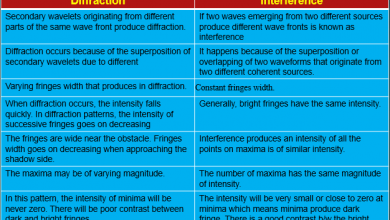Difference between speed and velocity in tabular form for class 9

Speed is defined as the distance traveled by a body in a given interval of time. Velocity is defined as the displacement of a body in a given interval of time. It is a scalar quantity.
The difference between speed and velocity can be thought of as the rate at which an object covers distance. Speed is the time rate at which an object is moving along a path. while Velocity is a vector quantity that refers to “the rate at which an object changes its position.
We often find the terms speed and velocity similar; however, practically, there’s a difference between them in terms of nature. speed will be distance/time, i.e., 120/5 or 24 kmph.
Velocity as a Vector Quantity
Velocity is a vector quantity that refers to “the rate at which an object changes its position.” Imagine a person moving rapidly – one step forward and one step back – always returning to the original starting position.
Types of Speed:
-
Uniform Speed: When the distance traveled by a body is equal in an equal interval of time then the speed is uniform.
-
Non-uniform Speed: When the distance traveled by a body is unequal in an equal interval of time then the speed is known as non-uniform speed.
-
Velocity: Velocity is a physical vector quantity. It has a magnitude as well as direction. In calculus, velocity is the first derivative of the position with respect to time. Velocity, in other words, is the rate of change in the position of the body with reference to time. Its SI unit is a meter per second.
Types of Velocity:
-
Constant Velocity: A velocity that does not change with the direction and speed and moves along a straight line is called constant velocity.
-
Changing Velocity: A velocity that changes with the speed and direction or changes either speed or direction is called changing velocity. This is also called acceleration.
-
Instant (Instantaneous) Velocity: When at a particular time, speed and direction change, then that phenomenon is called instantaneous velocity.
-
Terminal Velocity: When gravity takes over an object and results in the falling down of the object towards the earth through the atmosphere the phenomenon is called terminal velocity.
Difference between speed and velocity in tabular form
| Speed | Velocity |
|---|---|
| Distance traveled by a moving body per unit time is called speed. | Distance traveled by a moving body per unit time in a particular direction is called velocity. |
| Speed is a scalar quantity. So it has only magnitude but no specific direction. | Velocity is a vector quantity. So it has both magnitude and direction. |
| The average speed of a moving body can never be zero. | The average velocity of a moving body can be zero because of the algebraic summation. |
| The speed of a moving body can never be negative. It always has a finite positive value. | The velocity of a moving body can be negative based on the measured direction. |
| A moving body having uniform velocity must have uniform speed. | A moving body having uniform speed may not necessarily have uniform velocity. |
| Speed of a body cannot be resolved; in fact, it always has same value irrespective of measured direction. | The velocity of a body can be resolved in two mutually perpendicular directions using sine or cosine of adjacent angle. |
| While specifying speed of a body, only value with unit is sufficient. | While specifying velocity of body, the direction must be specified along with the value and unit. |
Its instantaneous speed tells you how fast it’s going in a single instance.
There are two ways to measure an object’s speed: its average speed and its instantaneous speed. The average speed tells you the average measurement of how fast it was going over a period of time.
- Speed – The rate of distance traveled by a moving object over time.
- Velocity – The rate of displacement of a moving object over time.
How Speed Works?
A powerful stimulant that keeps people alert, usually sold as an off-white or pinkish powder – that sometimes look like small crystals.
There are three units to measure speed:
- m/s – meters per second (used by The International System of Units and Measurements)
- kph – kilometers per hour (used by countries that use the metric system)
- mph – miles per hour (used in the United States)
There are several tools that measure an object’s speed. Tachometers measure an engine’s speed in rpms (revolutions per minute) and speedometers measure the speed in an automobile. RADAR can also measure the speed of a moving object from a distance.
How Velocity Works?
Velocity depends on the direction an object travels. It incorporates the speed of that object as well as the difference between its starting place and its ending place. You use the same units for speed (m/s, kph, and mph) when measuring velocity, but factoring in its direction.
You need to calculate the velocity of objects when determining where they might go. Like speed measurements, velocity can be measured by an object’s average velocity and its instantaneous velocity.
Equations for Speed and Velocity
It’s easiest to see the difference between speed and velocity when you compare their equations. In order to measure an object’s speed (s), you measure its distance (d) over time (t):
s = d/t
Once you know the object’s speed, you can calculate its average velocity by calculating the change in displacement (d) over the change in time (t):
v = Δs/Δt
Conclusion:This information may not seem as straightforward for an everyday traveler, but when studying physics, it’s very important to know the difference between an object’s speed and velocity. When they are the same value, the object has traveled in a straight line. Different values between speed and velocity indicate that the object’s path was not straight.
Physics Differences:



